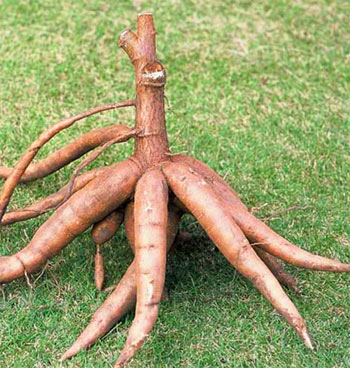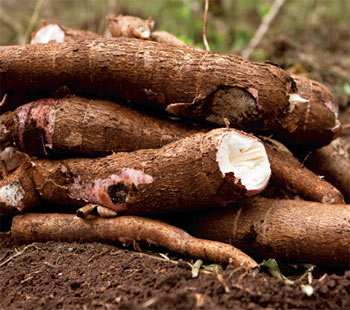Women Fitness presents before its readers an informative resource to create the awareness and know about the most dangerous fruits and vegetables in the world. Sometimes out of curiosity or ignorance we consume these fruits and vegetables, it shall make you aware about their toxicity, poision.
1. Cassava

Cassava (Manihot esculenta), also called manioc, yuca, balinghoy, mogo, mandioca, kamoteng kahoy, and manioc root, a woody shrub of the Euphorbiaceae (spurge family) native to South America, is extensively cultivated as an annual crop in tropical and subtropical regions for its edible starchy, tuberous root, a major source of carbohydrates. It differs from the similarly spelled yucca, an unrelated fruit-bearing shrub in the Asparagaceae family. Cassava, when dried to a starchy, powdery (or pearly) extract is called tapioca; its fermented, flaky version is named garri.
Cassava is the third-largest source of food carbohydrates in the world. Cassava is a major staple food in the developing world, providing a basic diet for over half a billion people. It is one of the most drought-tolerant crops, capable of growing on marginal soils. Nigeria is the world’s largest producer of cassava. Cassava root is a good source of carbohydrates, but a poor source of protein. A predominantly cassava root diet can cause protein-energy malnutrition. Cassava is classified as sweet or bitter. Like other roots and tubers, cassava contains antinutritional factors and toxins. It must be properly prepared before consumption. Improper preparation of cassava can leave enough residual cyanide to cause acute cyanide intoxication and goiters, and may even cause ataxia or partial paralysis. Nevertheless, farmers often prefer the bitter varieties because they deter pests, animals, and thieves. The more-toxic varieties of cassava are a fall-back resource (a “food security crop”) in times of famine in some places.
Cassava roots and leaves should not be consumed raw because they contain two cyanogenic glucosides, linamarin and lotaustralin. These are decomposed by linamarase, a naturally occurring enzyme in cassava, liberating hydrogen cyanide (HCN). Cassava varieties are often categorized as either sweet or bitter, signifying the absence or presence of toxic levels of cyanogenic glucosides, respectively. The so-called sweet (actually not bitter) cultivars can produce as little as 20 milligrams of cyanide (CN) per kilogram of fresh roots, whereas bitter ones may produce more than 50 times as much (1 g/kg). Cassavas grown during drought are especially high in these toxins. A dose of 25 mg of pure cassava cyanogenic glucoside, which contains 2.5 mg of cyanide, is sufficient to kill a rat. Excess cyanide residue from improper preparation is known to cause acute cyanide intoxication, and goiters, and has been linked to ataxia (a neurological disorder affecting the ability to walk, also known as konzo). It has also been linked to tropical calcific pancreatitis in humans, leading to chronic pancreatitis.
Societies that traditionally eat cassava generally understand some processing (soaking, cooking, fermentation, etc.) is necessary to avoid getting sick. Symptoms of acute cyanide intoxication appear four or more hours after ingesting raw or poorly processed cassava: vertigo, vomiting, and collapse. In some cases, death may result within one or two hours. It can be treated easily with an injection of thiosulfate (which makes sulfur available for the patient’s body to detoxify by converting the poisonous cyanide into thiocyanate).
“Chronic, low-level cyanide exposure is associated with the development of goiter and with tropical ataxic neuropathy, a nerve-damaging disorder that renders a person unsteady and uncoordinated. Severe cyanide poisoning, particularly during famines, is associated with outbreaks of a debilitating, irreversible paralytic disorder called konzo and, in some cases, death. The incidence of konzo and tropical ataxic neuropathy can be as high as 3% in some areas.”
Cassava bread
Brief soaking (four hours) of cassava is not sufficient, but soaking for 18–24 hours can remove up to half the level of cyanide. Drying may not be sufficient, either.
For some smaller-rooted, sweet varieties, cooking is sufficient to eliminate all toxicity. The cyanide is carried away in the processing water and the amounts produced in domestic consumption are too small to have environmental impact. The larger-rooted, bitter varieties used for production of flour or starch must be processed to remove the cyanogenic glucosides. and then ground into flour, which is then soaked in water, squeezed dry several times, and toasted. The starch grains that float to the surface during the soaking process are also used in cooking. The flour is used throughout South America and the Caribbean. Industrial production of cassava flour, even at the cottage level, may generate enough cyanide and cyanogenic glycosides in the effluents to have a severe environmental impact.
A safe processing method used by the pre-Columbian indigenous people of the Americas is to mix the cassava flour with water into a thick paste and then let it stand in the shade for five hours in a thin layer spread over a basket. In that time, about 83% of the cyanogenic glycosides are broken down by the linamarase; the resulting hydrogen cyanide escapes to the atmosphere, making the flour safe for consumption the same evening.
The traditional method used in West Africa is to peel the roots and put them into water for three days to ferment. The roots then are dried or cooked. In Nigeria and several other west African countries, including Ghana, Benin, Togo, Ivory Coast, and Burkina Faso, they are usually grated and lightly fried in palm oil to preserve them. The result is a foodstuff called gari. Fermentation is also used in other places such as Indonesia. The fermentation process also reduces the level of antinutrients, making the cassava a more nutritious food.
The reliance on cassava as a food source and the resulting exposure to the goitrogenic effects of thiocyanate has been responsible for the endemic goiters seen in the Akoko area of southwestern Nigeria. People dependent on cassava risk cyanide poisoning and malnutrition diseases such as kwashiorkor and endemic goiter. A project called “BioCassava Plus” is developing a cassava with lower cyanogen glucosides and fortified with vitamin A, iron and protein to help the nutrition of people in sub-Saharan Africa. In 2011, the director of the program said he hoped to obtain regulatory approvals by 2017.
On 14 January 2008, the Centre for Food Safety (CFS) advised members of the public to avoid consuming Piranha brand crackers and snacks manufactured by Tixana Australia Pty Ltd. The appeal was made following a warning issued by the Food Standards Australia New Zealand (FSANZ) due to the higher-than-usual levels of naturally occurring cyanogenic glycosides in the ingredient cassava in a batch of exported vegetable crackers. The CFS contacted the relevant authorities and was informed that the affected products had been exported to Hong Kong. The CFS alerted the trade to stop selling the affected products.
What are Cyanogenic Glycosides?
 Cyanogenic glycosides are a group of chemical compounds which occur naturally in over 2 000 plant species. There are at least 25 cyanogenic glycosides known to be found in the edible parts of plants. Cyanogenic glycosides alone are relatively non-toxic. However, as a result of enzymatic hydrolysis by beta-glucosidase following maceration of plant tissues as they are eaten, or by the gut microflora, cyanogenic glycosides are broken down to release hydrogen cyanide which is toxic to both animals and humans. The potential toxicity of a cyanogenic plant depends primarily on its capacity to produce hydrogen cyanide.
Cyanogenic glycosides are a group of chemical compounds which occur naturally in over 2 000 plant species. There are at least 25 cyanogenic glycosides known to be found in the edible parts of plants. Cyanogenic glycosides alone are relatively non-toxic. However, as a result of enzymatic hydrolysis by beta-glucosidase following maceration of plant tissues as they are eaten, or by the gut microflora, cyanogenic glycosides are broken down to release hydrogen cyanide which is toxic to both animals and humans. The potential toxicity of a cyanogenic plant depends primarily on its capacity to produce hydrogen cyanide.
What are the Symptoms of Cyanide Poisoning?
In humans, the clinical signs of acute cyanide intoxication include rapid respiration, drop in blood pressure, rapid pulse, dizziness, headache, stomach pain, vomiting, diarrhoea, mental confusion, twitching and convulsions. Death due to cyanide poisoning can occur when the cyanide level exceeds the limit an individual is able to detoxify. The acute lethal dose of hydrogen cyanide for humans is reported to be 0.5 to 3.5 mg per kilogram of body weight. Children are particularly at risk because of their smaller body size.
Chronic cyanide intoxication may lead to the development of certain conditions including disturbance of thyroid function and neurological disorders. It tends to affect those individuals who have regular long-term consumption of cassava with poor nutrition status.
What is Cassava? What is it Used for?
The roots of cassava are rich in carbohydrates, mainly starch. According to Food and Agriculture Organization, cassava is the third most important source of calories in the tropics, after rice and corn. Cassava is consumed in a variety of ways, including eaten as whole root, grated root or root chips. In addition, it is prepared into flour which in turn can be used for cooking or production of cassava-based products such as breads, crackers, and puddings or beverages made with tapioca pearls. Cassava leaves are also eaten in some countries following extensive boiling. Apart from being used as human food, cassava products are also used as animal feed.
How should Cassava be Processed to Render it Safe for Consumption?
Cassava contains more than one form of cyanogenic glycosides. Different varieties of cassava are generally classified into two main types: sweet cassava and bitter cassava. Sweet cassava roots contain less than 50 mg per kilogram hydrogen cyanide on fresh weight basis, whereas that of the bitter variety may contain up to 400 mg per kilogram.
Sweet cassava roots can generally be made safe to eat by peeling and thorough cooking. However, bitter cassava roots require more extensive processing. One of the traditional ways to prepare bitter cassava roots is by first peeling and grating the roots, and then prolonged soaking of the gratings in water to allow leaching and fermentation to take place, followed by thorough cooking to release the volatile hydrogen cyanide gas. Cutting the roots into small pieces, followed by soaking and boiling in water is particularly effective in reducing the cyanide content in cassava. Whilst fresh cassava requires traditional methods to reduce its toxicity, adequately processed cassava flour and cassava-based products have very low cyanide contents and are considered safe to use.
What Other Edible Plants Contain Cyanogenic Glycosides?
Bamboo shoot is a popular food item among Asian population. The cyanogenic glycoside present in bamboo shoot is decomposed quickly in boiling water. Other edible plants containing cyanogenic glycosides include kernels within the pits of some stone fruits (e.g. bitter apricot kernels), lima beans, etc.
Additional resources:
Disclaimer
The Content is not intended to be a substitute for professional medical advice, diagnosis, or treatment. Always seek the advice of your physician or other qualified health provider with any questions you may have regarding a medical condition.